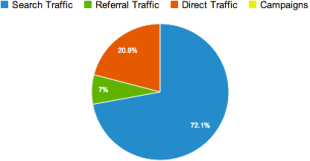Job Change Notifier is shutting down. They’re a utility that allowed LinkedIn users to be notified via email whenever one of their connections changed jobs. They didn’t run out of money due to mismanagement and their app is extremely popular. So why are they shutting down? Because LinkedIn is turning off the hose. They’re changing the API (application programming interface) so that the user has to log in every 60 and re-authorize program access. Company founder Roger Lee says this fundamentally damages the utility of his product.
“We’d have to remind users to log in to the app at least once every 60 days, or else the app would lose access,” Lee explains. “This, of course, makes the service a lot less useful.”
The startup graveyard is full of tombstone epitaphs with similar messages: “Our product was so awesome, <insert company name here> shut us off and did it themselves.” What does this have to do with social media marketing? It’s another reminder that all third party social media platforms are built on quicksand. Which means that it’s quite possible your marketing strategy is, too.
Here’s how to protect yourself.
A Short History of Social Media Marketing Rug-Pulling
[nonmember]The Inbound Marketing Inquirer is a weekly premium article that’s free to view for members. Create a free account now:
[register_inquirers (free)][/nonmember]
[ismember]
Job Change Notifier probably wasn’t a major cog in your social media marketing machine. But it could have easily been a different API change that led to your favorite client service shutting down or key component of your marketing workflow that suddenly stopped working. Twitter has been one of the most notorious rug-pullers and here’s a short list of casualties:
- Twitter Drops The Ecosystem Hammer: Don’t Try To Compete With Us On Clients, Focus On Data And Verticals
- Twitter Handcuffs Client Apps With New API Changes
- Latest API Casualty: TwitCleaner Quits Twitter
- Twitter Tightens API Rules: LinkedIn Partnership Is First Casualty
- Two More Twitter API Casualties: TweetChat and TweetGrid
- Twitter is removing Mobypicture uploads from its iOS app, are other video services to follow?
You get the picture. You might think that the key to protecting yourself is not to put all of your eggs in one basket. You wouldn’t be wrong but there’s a little more to it than that.
Marketing Asset Allocation
From Wikipedia:
Asset allocation is an investment strategy that attempts to balance risk versus reward by adjusting the percentage of each asset in an investment portfolio according to the investors risk tolerance, goals and investment time frame.
Asset allocation is a little more involved than simply diversifying a portfolio. As this Wikipedia definition suggests, it’s about actively balancing allocations based on risk. So let’s take a quick inventory of a typical set of online marketing assets:
- Your domain and its link profile on the web is a major marketing asset. It makes up a large portion of your organic SEO ranking factors.
- The content and pages on your website comprise another major portion of SEO ranking factors.
- Fans, friends and followers on social media.
- Engagement metrics on social media (likes, shares, retweets, +1’s, etc.)
- Social media content
- Email marketing lists
When examining these assets, I find it useful to classify them into two categories; stuff you own and stuff you don’t own. Your domain, website and email marketing lists are all assets you own and control. Anything that is associated with social media would be stuff you don’t own and only partially control. Remember that check box you clicked when you created your Twitter account that acknowledged reading and agreeing to their Terms of Service? Well, here’s a partial list bad things that can happen, all of which you agreed to:
- Your content could disappear at any time for any reason (virus, hacker, hardware failure) and they have no obligation to give it back to you.
- Accounts can be suspended or deleted at any time, for any reason, with not notice and no recourse. This happens more than you’d think on Facebook.
- There is absolutely no guarantee that the service will be functional at any given time. Hello Fail Whale?
- They reserve the right to add or remove functionality at any time at their sole discretion. See previous discussion of API changes.
You get the idea. So let’s take a look at how to assess and deal with these risks.
Taking Inventory
The first step is to take a quick inventory and understand where your website traffic is coming from. Which of the following looks more healthy to you?

Web traffic sources #1

Web traffic sources #2
What would happen to website #1 if a Google algorithm change dropped their search traffic by 50%? Their overall visits would drop by more than a third! If the same happened in example #2, they would only suffer a 10% drop. The second picture is obviously a much healthier picture.
The next step is to take a deeper dive into each of these sources and find out how segmented they are. For example, in the case of website #1, if their traffic is evenly spread across many different keywords, then the risk exposure may not actually be that great. But here’s a picture of the referral traffic for another website:
A worrying 84% of this site’s referral traffic is coming from Facebook. As long as it continues, that’s great but it is a risk factor.
Taking Action
Once you identify where your traffic is coming from, it may be useful to perform a risk analysis. This article is too long already so I’ll save that topic for another day but essentially, it involves identifying the likelihood and consequences of bad things happening for each of those channels. As I mentioned earlier, the risk profiles for stuff you own are drastically different from the stuff you don’t own.
It’s important to understand that the goal is not to avoid risk. Instead, it’s to estimate it as best as possible and balance the risk against the reward. Social media may be more risky than blogging but the rewards can also be great. Once the risks are estimated, it’s all about striking a proper balance between risk and reward.
[/ismember]
Top Marketing Stories of the Week
2013 Search Engine Ranking Factors
It’s here!! Every two years, Moz runs a Ranking Factors study to determine which attributes of pages and sites have the strongest association with ranking highly in Google.
50 Percent Of Companies Struggling With SEO Aren’t Integrating Social Media [Survey]
I’m running out of words to describe how badly companies are fumbling the football when it comes to social media…
Psychology for Marketers: 9 Revealing Principles of Human Behavior
This is a decent article, but the comments are even better! Several of them point out that Hubspot is violating a few of these principals.


